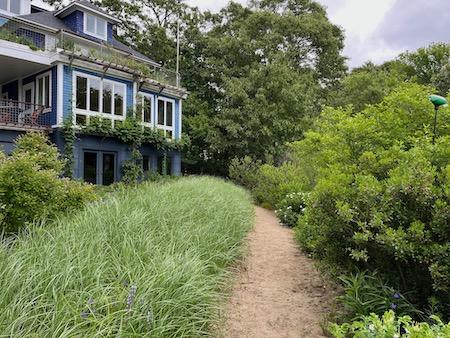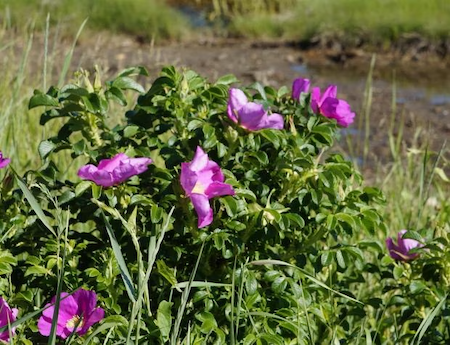Coastal beaches and dunes are highly dynamic and migratory systems—sand, gravel, and cobble are eroded, deposited, and reworked by wind and waves. Homeowners who attempt to maintain lawns and ornamental gardens in or adjacent to dunes and beaches will find that they are covered with sand after storms, or routinely damaged by salt spray. Rather than work against nature, the better strategy is to plant natural communities of beach and dune plants that thrive in this environment, and that offer substantial benefits, including dune stabilization and improved wildlife habitat and aesthetics (see below). Selecting plants that are adapted to beach and dune conditions will also offer you a lower-maintenance alternative. See the list below for appropriate plants, along with the sample landscape plan for a coastal dune.
NOTE: Before bringing in that backhoe (or even a shovel), you will need to contact your local Conservation Commission to determine if a permit is necessary. Please see Coastal Landscaping - Do You Need a Permit? for more information.
Planting to Help Build and Stabilize Dunes
For photos and additional information for most of the plant species listed below, see Coastal Landscaping in Massachusetts - Plant Highlights and Images.
Plants help build up the dunes and maintain their form. In major storms, these dunes will act as a buffer against waves and flooding.
In beach and dune systems, the pioneer plants that grow at the wrack line (the line of seaweed and debris deposited by waves and tides) trap windblown sand and allow the dune to build. The roots of these plants, such as American beachgrass (Ammophila breviligulata), beach pea (Lathyrus japonicus), and seaside goldenrod (Solidago sempervirens), also act like glue and hold the dune together. The dune will continue to build up as long as the plants are there to catch and hold the sand. For property that is experiencing erosion from wave and wind activity, planting beachgrass can help build and stabilize the dune and provide protection to landward areas.
American beachgrass is the optimal choice for the fronting sand dunes (the dune closest to the beach), because of its fast growing subsurface rhizomes (stems) and roots, which spread beneath the sand and give rise to many new plants, helping to colonize the species in dune environments. Although woody vines and trees may look more stable, beachgrass can more quickly and effectively stabilize large areas of coastal dunes and banks. Beachgrass is also tolerant of salt spray, exposure to wind and waves, and being frequently over-topped by accumulations of sand. In fact, the wind-blown sand promotes a healthier and more vigorous stand of beachgrass by providing nutrients, forcing new rhizomes to sprout, and avoiding the build-up of unhealthy thatch. For healthier plant stands, a mix of grasses and other plants can be planted, providing a varied resistance to disease, pests, and local climatic conditions.
Secondary dune systems (those landward of the fronting dunes) are typically beyond the reach of regular wave action but are still exposed to salt spray, wind, or storm waves. Secondary dunes are habitat for hardy plants such as beach heather (Hudsonia tomentosa), Virginia creeper (Parthenocissus quinquefolia), lowbush blueberry (Vaccinium angustifolium), bayberry (Morella caroliniensis), beach plum (Prunus maritima), pitch pine (Pinus rigida), Eastern red cedar (Juniperus virginiana), and white oak (Quercus alba). Due to their adaptation to dry, sandy, loamy, sometimes acidic, and nutrient-poor soils, and their tolerance to salt spray, these plants are particularly useful for stabilizing coastal sand dunes. They are also a good choice for yards that are exposed to wind and waves where little else will grow successfully. Saltmeadow cordgrass (Spartina patens) and spike grass (Distichlis spicata), although prevalent in the high salt marshes, can also effectively colonize dune areas, particularly in troughs between dunes. These grasses are dominant in these areas because most other sand dune species cannot tolerate wet to saturated soil conditions.
Planting to Enhance Wildlife Habitat and Aesthetics
For photos and additional information for most of the plant species listed below, see Coastal Landscaping in Massachusetts - Plant Highlights and Images.
On dunes, planting hardy shrubs that are good for dune stability is also good for wildlife. Bayberry (Morella caroliniensis) berries, for example, provide a valuable source of food in the winter/early spring for local and migratory songbirds, and the shrub's thicket-forming character provides shelter. Likewise, the bearberry (Arctostaphylos uva-ursi) fruits ripen in autumn and last through winter, providing a source of food for birds and mammals when other fruits are scarce. The beach plum (Prunus maritima) adds diversity and beauty with appealing white flowers and edible purple fruit.
Beach plants can also provide cover and habitat for wildlife, such as shorebirds. Common and Least Terns, Piping Plovers, and American Oystercatchers nest on beaches or within the vegetated dunes. Seaside goldenrod has been known to attract fall monarch butterflies. To create a beach-type community of plants, a scattered cover of seabeach sandwort (Honckenya peploides), sea rocket (Cakile edentula), dune grass (Leymus mollis), beach pea (Lathyrus japonicus), seaside goldenrod (Solidago sempervirens), and other species listed in the Beaches and Dunes Plant Lists below are good choices, since they are naturally found at the foot of the dunes and protected beaches. Accordingly, these species will need a sandy, well-drained substrate to flourish. (Before undertaking planting activities in these resource areas, however, check with the Natural Heritage and Endangered Species Program [NHESP] or their most recent Priority Habitat and Estimated Habitat Maps, which are available online to determine if your site is in or near mapped endangered or threatened species habitat.)
If you live on a protected waterbody that experiences tidal fluctuations, you can plant saltmeadow cordgrass (Spartina patens), saltmarsh cordgrass (Spartina alterniflora), or black grass (Juncus gerardii) in the intertidal zone (between the low-tide and high-tide line) to provide habitat and stabilize the soils.
Selecting Plants
Very few species of plants are resilient enough to withstand the rugged conditions on a coastal beach or dune. Sandy soils, exposure to salt and wind, and wind-blown sand make a very specific niche for only the hardiest of plants to survive. Particular native species have survived and thrived in this environment for years and are therefore the obvious choice for planting.
The following list includes plants for more exposed areas and more sheltered areas of the coastal beach and coastal dune. Some of the recommended species may overlap, due to their ability to tolerate various conditions. For the plants listed below, the common name links to plant photos and descriptions and is followed by the scientific name and a note on whether the plant is a native species (see: Definitions of Native and Non-Native Plant Species). CZM recommends the use of natives wherever possible, and the vast majority of the plants listed below are native. Certain non-native species that have specific coastal landscaping advantages and are not known to be invasive have also been listed. These plants are labeled as “not native” and their state or country of origin is given in parentheses.
Coastal Beach Plant List
Plant List for Sheltered Intertidal Areas
Sheltered intertidal areas (between the low-tide and high-tide line) of beach, marsh, and even rocky environments are home to particular plant species that can tolerate extreme fluctuations in water, salinity, and temperature. The following plants are appropriate for these conditions along the Massachusetts coast.
- Black Grass (Juncus gerardii) (native)
- Marsh Elder (Iva frutescens) (native)
- Narrow-Leaf Evening Primrose, Sundrops (Oenothera fruticosa) (native)
- New York Aster (Symphyotrichum novi-belgii)(native)
- Saltgrass (Distichlis spicata) (native)
- Saltmarsh Cordgrass (Spartina alterniflora) (native)
- Saltmeadow Cordgrass (Spartina patens) (native)
- Sea Lavender (Limonium carolinianum or nashii) (native)
- Switchgrass (Panicum virgatum) (native)
Plant List for a Dry Beach
Dry beach areas are home to plants that can tolerate wind, wind-blown sand, salt spray, and regular interaction with waves and flood waters. Certain plants actually thrive on accumulations of sand to help them grow. The plants listed below are appropriate for dry beach conditions in Massachusetts.
- American Beachgrass (Ammophila breviligulata) (native)
- Beach Pea (Lathyrus japonicus) (native)
- Saltmeadow Cordgrass (Spartina patens) (native)
- Sea Rocket (Cakile edentula) (native)
- Seabeach Sandwort (Honckenya peploides) (native)
- Seaside Goldenrod (Solidago sempervirens) (native)
Coastal Dune Plant List
Plant List for Exposed Areas of a Coastal Dune
Fronting dunes and exposed secondary dunes are habitat for plant species that can tolerate wind, wind-blown sand, and salt spray; endure interaction with waves and flooding; and often even thrive on sand inundation. The plants listed below, as well as those listed above for Dry Beach areas, are appropriate for these environments along the Massachusetts coast.
- American Beachgrass (Ammophila breviligulata) (native)
- American Dunegrass (Leymus mollis) (native)
- Beach Heather (Hudsonia tomentosa) (native)
Plant List for More Sheltered Areas of a Coastal Dune
More protected secondary dunes are able to host a greater variety of plant species, because they are more sheltered from wind, salt-spray, and wave action. The plants listed below, as well as those listed above for Exposed Areas of a Coastal Dune, are appropriate for these more sheltered dune environments in Massachusetts.
Grasses and Perennials
- Black Grass (Juncus gerardii) (native)
- Coastal Panic Grass (Panicum amarum var. amarulum) (not native; native to New Jersey south to Mexico)
- Eastern Showy Aster (Eurybia spectabilis) (native)
- Hyssop-leaved Boneset (Eupatorium hyssopifolium) (native)
- New York Aster (Symphyotrichum novi-belgii)(native)
- Saltgrass (Distichlis spicata) (native)
- Saltmeadow Cordgrass (Spartina patens) (native)
- Sea Lavender (Limonium carolinianum or nashii) (native)
- Switchgrass (Panicum virgatum) (native)
- White Goldenrod, Silverrod (Solidago bicolor) (native)
Shrubs, Groundcovers, and Vines
- Bayberry (Morella caroliniensis) (native)
- Beach Plum (Prunus maritima) (native)
- Bearberry (Arctostaphylos uva-ursi) (native)
- Common Juniper (Juniperus communis) (native)
- Large Cranberry (Vaccinium macrocarpon) (native)
- Lowbush Blueberry (Vaccinium angustifolium) (native)
- Red Chokeberry (Aronia arbutifolia) (native)
- Sweet Fern (Comptonia peregrina) (native)
- Virginia Creeper (Parthenocissus quinquefolia) (native)
- Virginia Rose (Rosa virginiana) (native)
- Wild Strawberry (Fragaria virginiana) (native)
- Winged Sumac (Rhus copallinum) (native)
Trees
- Black Cherry (Prunus serotina) (native)
- Downy Serviceberry/Shadbush (Amelanchier arborea) (native)
- Eastern Red Cedar (Juniperus virginiana) (native)
- Gray Birch (Betula populifolia) (native)
- Pitch Pine (Pinus rigida) (native)
- White Oak (Quercus alba) (native)
More Information
For more information about many of the plants that are listed above, visit Native Plant Trust’s Go Botany and Garden Plant Finder pages, the United States Department of Agriculture (USDA) Natural Resources Conservation Service's (NRCS) PLANTS Database, the University of Connecticut (UConn) Plant Database of Trees, Shrubs, and Vines, and the Lady Bird Johnson Wildflower Center Plant Database.
Caution with a Very Common Coastal Plant - Rosa Rugosa
Rugosa rose (Rosa rugosa) is considered to be non-native (native to eastern Asia) and potentially invasive in some regions or habitats of Massachusetts and may displace desirable vegetation if not properly managed. Though the shrub is extremely tolerant of sea spray and effective at directing pedestrian access away from dunes, it has the ability to form dense thickets that shade and outcompete other native bank, beach, and dune plants. Rugosa rose can also spread vigorously through both seed dispersal (carried by the rose hips) and underground rhizomes. Therefore, care should be taken when considering planting rugosa rose on coastal properties.

